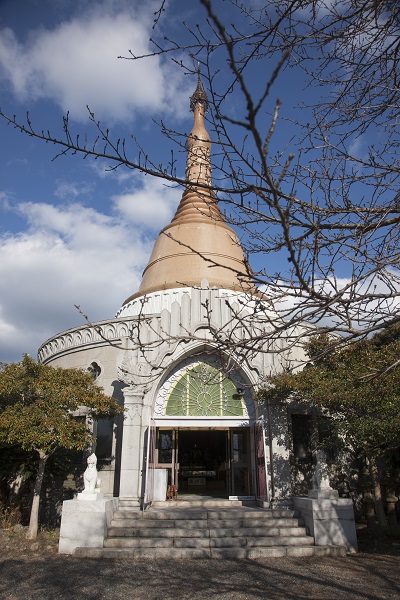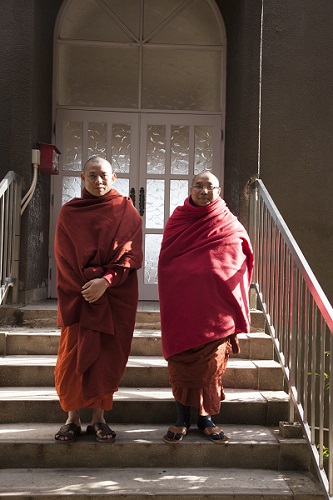
Pagoda means a stupa in which Buddhist relics are enshrined, and in Myanmar, it is called Paya.
This content is from 2012.
World Peace Pagoda
Completed construction: September 1958 (Showa 33)
The responsible organization for construction: Moji World Peace Pagoda Construction Committee
Site area: Approximately 3,400 tsubo (11,220 m2)
Building facilities: World Peace Pagoda, monastery, precept hall, training hall
Total construction cost: 40 million yen
(Burma Government Buddhist Association 20 million yen, Moji World Peace Pagoda Construction Committee 20 million yen)
Pagoda height: 45m
Height of the sitting Buddha: 1.6m
Background of the establishment
In December 1954, the Third International Buddhist Congress was held at Kabwe Pagoda in Burma (now Myanmar) to commemorate the 2,500th anniversary of the death of Buddha. At this time, the Japanese representative was impressed by Theravada (southern) Buddhism, and the following year, in 1955, he requested the Myanmar government to send 13 people (12 men and 1 woman) to study Theravada Buddhism. He was sent to live at the Aparagoyana Monastery, where he studied Buddhist scriptures and was instructed in zazen meditation. Afterward, they returned to Japan, established the Japanese Shakyamuni Shōhokai, and in August 1956 (Showa 31) held a meeting between the Japanese and Burmese sides in the name of exchange between Japanese Buddhism (Mahayana Buddhism) and Burmese Buddhism (Hinayana Buddhism). The construction of the World Peace Pagoda was decided upon, and the Burmese side, who wanted to establish a missionary center in Japan to propagate Theravada Buddhism, and the Japanese side, who wanted to enshrine the spirits of those who died in World War II, agreed. It was done. Moji City was selected from two candidate locations (Kyoto City and Moji City).
In September of the same year, the Moji World Peace Pagoda Construction Committee was established, Mojita Mayor Momotaro Yanagida was appointed as its chairman, and the ground-breaking ceremony was held in the same month, and construction of the Moji World Peace Pagoda began. The monastery was completed in 1957 (Showa 32), and the pagoda and all five other buildings were completed the following year in 1958 (Showa 33). Upon completion, five monks were dispatched from the Burmese side, and an inauguration ceremony was held on September 9 of the same year.
After that, the monks were permanently stationed there, observing the strict precepts of Sorei, Sanki, the Five Precepts, and Hinayana Buddhism 227 (celibacy for life, eating two meals a day, not participating in politics, having nothing to do with money, etc.), and receiving prayers from various people every day. In addition to preaching the Dharma in response to the requests of those who came, he also recited sutras and prayed for the souls of those who lost their lives in the Greater East Asia War every morning.

Current status and future direction (2012)
Moji World Peace Pagoda has been operating smoothly, but after the chief priest, Grand Priest U Keminda, passed away in December 2011, due to financial difficulties, the World Peace Pagoda, which had been the main museum has been closed due to the aging of the members of the comradeship association that supported it.
However, local volunteers, mainly former executives, the Myanmar Buddhist Association, and the Myanmar Embassy continued to hold discussions toward reopening, and on August 28, 2012, a new Buddhist temple from Myanmar was added to the World Peace Pagoda. Two monks, Elder Wimala and Monsignor U Khemindara, were dispatched and began living at the World Peace Pagoda the following night, the 29th. In other words, the World Peace Pagoda was reopened on August 29th.
At the same time, the Myanmar Buddhist Association and the Myanmar Embassy commissioned local businessman Susumu Sakuma (chairman of the Sanray Group) to rebuild the World Peace Pagoda. Mr. Sakuma established the Japan-Myanmar Buddhist Cultural Exchange Association, which is made up of local businessmen and academic experts and is providing support for the rebuilding of the World Peace Pagoda, including not only management but also funding and renovation of aging facilities.
Currently, the two monks are working hard on missionary activities, and the number of locals and other worshipers who have learned of the reopening has increased, and the World Peace Pagoda is regaining its former bustle.
